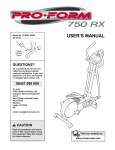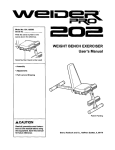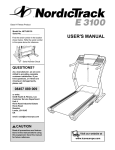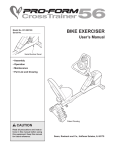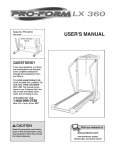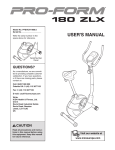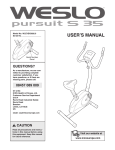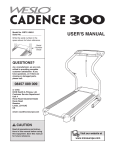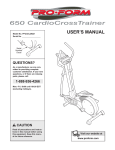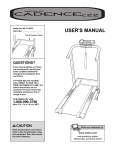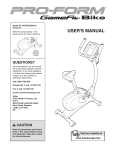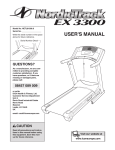Download USER`S MANUAL - Icon Heath & Fitness
Transcript
ORDERING REPLACEMENT PARTS To order replacement parts, contact the ICON Health & Fitness, Ltd. office, or write: ICON Health & Fitness, Ltd. Customer Service Department Unit 4 Revie Road Industrial Estate Revie Road Beeston Leeds, LS118JG UK Model No. PFEVEX23021 Serial No. Tel: USER'S MANUAL 08457 089 009 Outside the UK: 0 (044) 113 387 7133 Fax: 0 (044) 113 387 7125 Serial Number Decal To help us assist you, please be prepared to give the following information: • the MODEL NUMBER of the product (PFEVEX23021) • the NAME of the product (PROFORM® 985 C exercise cycle) • the SERIAL NUMBER of the product (see the front cover of this manual) • the KEY NUMBER and DESCRIPTION of the part(s) (see page 18). QUESTIONS? As a manufacturer, we are committed to providing complete customer satisfaction. If you have questions, or if there are missing parts, please call: 08457 089 009 Or write: ICON Health & Fitness, Ltd. Customer Service Department Unit 4 Revie Road Industrial Estate Revie Road Beeston Leeds, LS118JG UK email: [email protected] CAUTION PROFORM is a registered trademark of ICON Health & Fitness, Inc. Part No. 195834 R0703A Printed in China © 2003 ICON Health & Fitness, Inc. Read all precautions and instructions in this manual before using this equipment. Keep this manual for future reference. Visit our website at www.iconeurope.com TABLE OF CONTENTS EXPLODED DRAWING—Model No. PFEVEX23021 IMPORTANT PRECAUTIONS . . . . . . . . . . . . . . . . . . . . . . . . . . . . . . . . . . . . . . . . . . . . . . . . . . . . . . . . . . . . .2 BEFORE YOU BEGIN . . . . . . . . . . . . . . . . . . . . . . . . . . . . . . . . . . . . . . . . . . . . . . . . . . . . . . . . . . . . . . . . . . .3 ASSEMBLY . . . . . . . . . . . . . . . . . . . . . . . . . . . . . . . . . . . . . . . . . . . . . . . . . . . . . . . . . . . . . . . . . . . . . . . . . . .4 HOW TO OPERATE THE EXERCISE CYCLE . . . . . . . . . . . . . . . . . . . . . . . . . . . . . . . . . . . . . . . . . . . . . . . . .8 MAINTENANCE AND TROUBLESHOOTING . . . . . . . . . . . . . . . . . . . . . . . . . . . . . . . . . . . . . . . . . . . . . . . . .14 CONDITIONING GUIDELINES . . . . . . . . . . . . . . . . . . . . . . . . . . . . . . . . . . . . . . . . . . . . . . . . . . . . . . . . . . . .16 PART LIST . . . . . . . . . . . . . . . . . . . . . . . . . . . . . . . . . . . . . . . . . . . . . . . . . . . . . . . . . . . . . . . . . . . . . . . . . . .18 EXPLODED DRAWING . . . . . . . . . . . . . . . . . . . . . . . . . . . . . . . . . . . . . . . . . . . . . . . . . . . . . . . . . . . . . . . . .19 ORDERING REPLACEMENT PARTS . . . . . . . . . . . . . . . . . . . . . . . . . . . . . . . . . . . . . . . . . . . . . . . .Back Cover 52 19 52 52 18 16 51 66 71 50 7 R0703A 50 17 36 7 66 66 8 52 13 12 27 9 6 IMPORTANT PRECAUTIONS WARNING: To reduce the risk of serious injury, read the following important precau- 26 15 66 70 70 5 57 tions before using the exercise cycle. 1. Read all instructions in this manual before using the exercise cycle. 7. The exercise cycle should not be used by persons weighing more than 115 kg (250 lbs.). 2. It is the responsibility of the owner to ensure that all users of the exercise cycle are adequately informed of all precautions. Use the exercise cycle only as described in this manual. 69 14 30 29 35 32 11. The pulse sensor is not a medical device. Various factors, including the user's movement, may affect the accuracy of heart rate readings. The pulse sensor is intended only as an exercise aid in determining heart rate trends in general. 5. Keep children under the age of 12 and pets away from the exercise cycle at all times. 6. Wear appropriate clothes when exercising; do not wear loose clothes that could become caught on the exercise cycle. Always wear athletic shoes for foot protection. 12. The exercise cycle is intended for home use only. Do not use the exercise cycle in a commercial, rental, or institutional setting. WARNING: Before beginning this or any exercise program, consult your physician. This is especially important for persons over the age of 35 or persons with pre-existing health problems. Read all instructions before using. ICON assumes no responsibility for personal injury or property damage sustained by or through the use of this product. 2 20 58 10. The exercise cycle does not have a freewheel; the pedals will continue to move until the flywheel stops. 58 43 22 44 23 31 67 63 74 62 5361 40 48 37 62 63 59 54 23 28 48 66 33 2 69 21 28 65 67 4. Inspect and properly tighten all parts regularly. Replace any worn parts immediately. 38 65 9. If you feel pain or dizziness whilst exercising, stop immediately and cool down. 3. Use the exercise cycle indoors on a level surface. Keep the exercise cycle away from moisture and dust. Place a mat under the exercise cycle to protect the floor. 10 30 8. Always keep your back straight when using the exercise cycle; do not arch your back. 56 68 60 40 39 1 10 56 25 63 75 73 42 44 41 46 45 49 24 53 48 61 55 72 66 60 11 47 63 64 45 4 3 34 4 65 60 19 PARTS LIST—Model No. PFEVEX23021 Key No. Qty. 1 2 3 4 5 6 7 8 9 10 11 12 13 14 15 16 17 18 19 20 21 22 23 24 25 26 27 28 29 30 31 32 33 34 35 36 37 38 39 1 1 1 2 1 1 2 2 1 5 1 1 1 1 1 1 1 1 1 1 1 1 2 1 1 1 1 2 2 2 1 1 1 1 1 1 1 1 1 Description Key No. Qty. Frame Front Stabiliser Rear Stabiliser Rear Endcap Seat Post Seat Bracket Handlebar Endcap Foam Grip Seat Adjustment Knob M8 Nylon Locknut M6 x 38mm Screw Seat Upright Upright Bushing Handlebar/Handgrip Pulse Sensor Console Left Side Shield Right Side Shield Side Shield Cover Seat Upright Bushing Crank Assembly Reed Switch Clamp M4 x 5mm Screw Left Pedal Left Pedal Strap Right Pedal Right Pedal Strap Adjustment Knob M6 x 72mm Button Screw Wheel Left Front Endcap Right Front Endcap M6 x 25.4mm Button Screw Adjustment Motor Lower Wire Harness Upper Wire Harness Flywheel Magnet Flywheel Axle 40 41 42 43 44 45 46 47 48 49 50 51 52 53 54 55 56 57 58 59 60 61 62 63 64 65 66 67 68 69 70 71 72 73 74 75 # # 2 1 1 1 2 2 1 1 5 1 3 3 7 2 1 1 2 1 2 1 4 2 2 4 4 4 11 2 1 4 4 2 1 1 1 1 1 2 R0703A Description Flywheel Bearing “C” Magnet Left Crank Arm Reed Switch/Wire Crank Bearing M5 Nut Adjustment Cable Return Spring M6 Nylon Locknut “C” Magnet Bracket M10 Black Split Washer M10 x 27mm Button Screw M4 x 25mm Screw Eyebolt Pulley M6 x 16mm Button Bolt Flange Screw Right Crank Arm M6 x 8mm Screw Belt M6 Nut M8 Nylon Jam Nut Flywheel Washer M10 Black Nylon Locknut Motor Washer M10 x 112mm Carriage Bolt M4 x 16mm Screw Levelling Foot “U” Bracket M6 x 18mm Bolt M8 Split Washer M4 x 12mm Round Head Screw M6 Washer Snap Ring Thrust Washer Spacer User’s Manual Allen Wrench Note: “#” indicates a non-illustrated part. Specifications are subject to change without notice. See the back cover of this manual for information about ordering replacement parts. BEFORE YOU BEGIN Congratulations for selecting the new PROFORM® 985 C exercise cycle. Cycling is one of the most effective exercises for increasing cardiovascular fitness, building endurance, and toning the entire body. The PROFORM® 985 C offers an impressive array of features to let you enjoy this healthful exercise in the convenience and privacy of your home. after reading this manual, please call our Customer Service Department at 08457 089 009. To help us assist you, please note the product model number and serial number before calling. The model number is PFEVEX23021. The serial number can be found on a decal attached to the exercise cycle (see the front cover of this manual). For your benefit, read this manual carefully before you use the exercise cycle. If you have questions Before reading further, please familiarize yourself with the parts that are labeled in the drawing below. Water Bottle Holder* Bookrack Console Handlebar Handgrip Pulse Sensor FRONT Seat Adjustment Knob Adjustment Knob Pedal/Strap Adjustment Knob Wheel REAR Levelling Foot *No water bottle is included 18 RIGHT SIDE 3 SUGGESTED STRETCHES ASSEMBLY Assembly requires two persons. Place all parts of the exercise cycle in a cleared area and remove the packing materials. Do not dispose of the packing materials until assembly is completed. Assembly requires the included tools and your own adjustable spanners screwdriver . and Phillips Use the part drawings below to identify the small parts used in assembly. The number in parenthesis below each drawing refers to the key number of the part, from the PART LIST on page 18. The second number refers to the quantity needed for assembly. Note: Some small parts may have been pre-attached for shipping. If a part is not in the parts bag, check to see if it has been pre-attached. The correct form for several basic stretches is shown at the right. Move slowly as you stretch—never bounce. 1 1. Toe Touch Stretch Stand with your knees bent slightly and slowly bend forward from your hips. Allow your back and shoulders to relax as you reach down toward your toes as far as possible. Hold for 15 counts, then relax. Repeat 3 times. Stretches: Hamstrings, back of knees and back. 2 2. Hamstring Stretch Sit with one leg extended. Bring the sole of the opposite foot toward you and rest it against the inner thigh of your extended leg. Reach toward your toes as far as possible. Hold for 15 counts, then relax. Repeat 3 times for each leg. Stretches: Hamstrings, lower back and groin. M8 Nylon Locknut (10)–4 M4 x 16mm Screw (66)–1 M10 Black Nylon Locknut (63)–4 M8 Split Washer (70)–4 M6 x 25.4mm Button Screw (33)–1 M10 Black Split Washer (50)–3 M10 x 27mm Button Screw (51)–3 3. Calf/Achilles Stretch With one leg in front of the other, reach forward and place your hands against a wall. Keep your back leg straight and your back foot flat on the floor. Bend your front leg, lean forward and move your hips toward the wall. Hold for 15 counts, then relax. Repeat 3 times for each leg. To cause further stretching of the achilles tendons, bend your back leg as well. Stretches: Calves, achilles tendons and ankles. 3 4 4. Quadriceps Stretch M10 x 112mm Carriage Bolt (65)–4 With one hand against a wall for balance, reach back and grasp one foot with your other hand. Bring your heel as close to your buttocks as possible. Hold for 15 counts, then relax. Repeat 3 times for each leg. Stretches: Quadriceps and hip muscles. 5 5. Inner Thigh Stretch Sit with the soles of your feet together and your knees outward. Pull your feet toward your groin area as far as possible. Hold for 15 counts, then relax. Repeat 3 times. Stretches: Quadriceps and hip muscles. 4 17 CONDITIONING GUIDELINES The following guidelines will help you to plan your exercise program. Remember that proper nutrition and adequate rest are essential for successful results. Fat Burning To burn fat effectively, you must exercise at a relatively low intensity level for a sustained period of time. During the first few minutes of exercise, your body uses easily accessible carbohydrate calories for energy. Only after the first few minutes of exercise does your body begin to use stored fat calories for energy. If your goal is to burn fat, adjust the intensity of your exercise until your heart rate is between the two lower numbers in your training zone as you exercise. WARNING: • Before beginning this or any exercise program, consult your physician. This is especially important for persons over the age of 35 or persons with pre-existing health problems. Aerobic Exercise 1. Identify the Front Stabiliser (2), which has Wheels (30) on the ends. Whilst another person lifts the front of the Frame (1) slightly, attach the Front Stabiliser to the Frame with two M10 x 112mm Carriage Bolts (65) and two M10 Black Nylon Locknuts (63). Make sure that the Front Stabiliser is turned so the Wheels are not touching the floor. 1 30 65 30 2 1 63 2. Whilst another person lifts the back of the Frame (1) slightly, attach the Rear Stabiliser (3) to the Frame with two M10 x 112mm Carriage Bolts (65) and two M10 Black Nylon Locknuts (63). 2 63 3 63 • The pulse sensor is not a medical device. Various factors, including the user's movement, may affect the accuracy of heart rate readings. The pulse sensor is intended only as an exercise aid in determining heart rate trends in general. If your goal is to strengthen your cardiovascular system, your exercise must be “aerobic.” Aerobic exercise is activity that requires large amounts of oxygen for prolonged periods of time. This increases the demand on the heart to pump blood to the muscles, and on the lungs to oxygenate the blood. For aerobic exercise, adjust the intensity of your exercise until your heart rate is near the highest number in your training zone. EXERCISE INTENSITY Whether your goal is to burn fat or to strengthen your cardiovascular system, the key to achieving the desired results is to exercise with the proper intensity. The proper intensity level can be found by using your heart rate as a guide. The chart below shows recommended heart rates for fat burning, maximum fat burning, and cardiovascular (aerobic) exercise. WORKOUT GUIDELINES 1 65 3. Whilst another person holds the Upright (13) in the position shown, connect the Upper Wire Harness (36) to the Lower Wire Harness (35). Carefully pull the upper end of the Upper Wire Harness to remove any slack from the Wire Harnesses; make sure that the connectors do not catch on the indicated rod. 3 Avoid pinching the Wire Harnesses (35, 36). Each workout should include the following three parts: A warm-up, consisting of 5 to 10 minutes of stretching and light exercise. A proper warm-up increases your body temperature, heart rate, and circulation in preparation for exercise. Training zone exercise, consisting of 20 to 30 minutes of exercising with your heart rate in your training zone. (During the first few weeks of your exercise program, do not keep your heart rate in your training zone for longer than 20 minutes.) A cool-down, with 5 to 10 minutes of stretching. This will increase the flexibility of your muscles and will help to prevent post-exercise problems. To find the proper heart rate for you, first find your age at the bottom line of the chart (ages are rounded off to the nearest ten years). Next, find the three numbers above your age. The three numbers are your “training zone.” The lowest number is the recommended heart rate for fat burning; the middle number is the recommended heart rate for maximum fat burning; the highest number is the recommended heart rate for aerobic exercise. EXERCISE FREQUENCY To maintain or improve your condition, plan three workouts each week, with at least one day of rest between workouts. After a few months of regular exercise, you may complete up to five workouts each week, if desired. Remember, the key to success is make exercise a regular and enjoyable part of your everyday life. 16 13 Turn the indicated Adjustment Knob (28) counterclockwise two or three turns to loosen it. Next, pull the Knob, insert the Upright (13) into the Frame (1), and then release the Knob. Be careful to avoid pinching the Wire Harnesses (35, 36). Move the Upright up and down slightly until the pin on the Knob snaps into one of the holes in the Upright. Then, turn the Knob clockwise until it is tight. Rod Slot 1 36 28 35 Tighten the M6 x 25.4mm Button Screw (33) into the Frame (1) and into the slot in the side of the Upright (13). 33 4. The Console (16) requires four 1.5V “D” batteries; alkaline batteries are recommended. Press the tab on the battery cover, and lift off the battery cover. Insert four batteries into the battery compartment. Make sure that the batteries are oriented as shown by the markings inside the battery compartment. Reattach the battery cover. 4 Battery Cover Tab Batteries 16 5 5. Connect the wire harness on the Handgrip Pulse Sensor (15) to the indicated wire harness on the Console (16). Insert both wire harnesses into the opening in the bottom of the Console. Then, insert the metal tube on the Handgrip Pulse Sensor into the opening in the bottom of the console. Be careful not to pinch the wire harnesses. 5 15 16 66 16 Bracket See the inset drawing. Tighten an M4 x 16mm Screw (66) into the indicated bracket on the Console (16) and into the metal tube on the Handgrip Pulse Sensor (15). Metal Tube Next, locate the Reed Switch (43). Turn the Left Crank Arm (42) until the Magnet (38) is aligned with the Reed Switch. Loosen but do not remove the Screw (66). Slide the Reed Switch slightly closer to or away from the Magnet. Retighten the Screw. Turn the Crank for a moment. Repeat until the console displays correct feedback. When the Reed Switch is correctly adjusted, reattach the Left Side Shield, the Side Shield Cover, and the Left Pedal. HOW TO MOVE THE EXERCISE CYCLE To move the exercise cycle, first stand in front of the exercise cycle, hold the handlebars, and place one foot on the front stabiliser. Pull the handlebars until the exercise cycle can be moved on the front wheels. Carefully move the exercise cycle to the desired location and then lower it. 38 15 6. Whilst another person holds the Console (16) in the position shown, connect the wire harness on the Console to the Upper Wire Harness (36). Insert the excess wire harness into the Upright (13). 66 6 42 Bookrack Attach the Console (16) to the Upright (13) with three M10 x 27mm Button Screws (51) and three M10 Black Split Washers (50). Be careful to avoid pinching the wire harnesses. 16 Wire Harness 36 Snap the bookrack onto the Console (16) where shown. 51 51 50 50 51 7. Turn the indicated Adjustment Knob (28) counterclockwise two or three turns to loosen it. Next, pull the Knob, insert the Seat Post (5) into the Frame (1), and then release the Knob. Move the Seat Post up and down slightly until the pin on the Knob snaps into one of the holes in the Seat Post. Then, turn the Knob clockwise until it is tight. 43 Avoid pinching the wire harnesses. 13 7 5 1 28 8. Attach the Seat (12) to the Seat Bracket (6) with four M8 Nylon Locknuts (10) and four M8 Split Washers (70). Note: The Nylon Locknuts and the Split Washers may be pre-attached to the underside of the Seat. Turn the Seat Adjustment Knob (9) counterclockwise two or three turns to loosen it. Next, pull the Knob, slide the Seat Bracket (6) into the top of the Seat Post (5), and then release the Knob. Move the Seat Bracket forward and backward slightly until the pin on the Knob snaps into one of the holes in the Seat Bracket. Then, turn the Knob clockwise until it is tight. 8 12 9 10 70 6 6 70 10 5 15 Place Foot Here Wheel MAINTENANCE AND TROUBLESHOOTING Inspect and tighten all parts of the exercise cycle regularly. Replace any worn parts immediately. HOW TO ADJUST THE REED SWITCH If the console does not display correct feedback, the reed switch should be adjusted. To adjust the reed switch, the Left Side Shield (17) must be removed. To clean the exercise cycle, use a damp cloth and a small amount of mild soap. Important: To avoid damage to the console, keep liquids away from the console and keep the console out of direct sunlight. 9. Identify the Left Pedal (24), which is marked with an “L.” Using an adjustable spanner, firmly tighten the Left Pedal counterclockwise into the Left Crank Arm (42). Tighten the Right Pedal (not shown) clockwise into the Right Crank Arm. Important: Tighten both Pedals as firmly as possible. After using the exercise cycle for one week, retighten the Pedals. For best performance, the Pedals must be kept tightened. 9 25 19 BATTERY REPLACEMENT 52 If the console display becomes dim, the batteries should be replaced; most console problems are the result of low batteries. See assembly step 4 on page 5 for instructions. Adjust the Left Pedal Strap (25) to the desired position, and press the end of the Pedal Strap onto the tab on the Left Pedal (24). Adjust the Right Pedal Strap (not shown) in the same way. 42 Tab 24 10. Make sure that all parts are properly tightened before you use the exercise cycle. Note: After assembly is completed, some extra parts may be left over. Place a mat beneath the exercise cycle to protect the floor. 18 71 HANDGRIP PULSE SENSOR TROUBLESHOOTING • Avoid moving your hands whilst using the handgrip pulse sensor. Excessive movement may interfere with heart rate readings. Do not hold the metal contacts too tightly; doing so may interfere with heart rate readings. If you purchase the optional chest pulse sensor (refer to page 13), follow the steps below to install the receiver and the jumper wire included with the chest pulse sensor. 52 Remove the seven Screws (52) from the Right Side Shield (18). Next, remove the Screw (71) from the right side of the Side Shield Cover (19). • For the most accurate heart rate reading, hold the metal contacts for about 15 seconds. INSTALLING THE RECEIVER FOR THE OPTIONAL CHEST PULSE SENSOR 1. Remove the indicated short screws and long screws from the back of the Console (16). Lift off the front of the Console. 1 Lift Here Short Screws 19 • Keep the metal contacts clean. The contacts can be cleaned with a soft cloth—never use alcohol, abrasives, or chemicals. 16 Long Screws HOW TO LEVEL THE EXERCISE CYCLE 71 After the exercise cycle has been moved to the location where it will be used, make sure that both ends of front stabiliser are touching the floor. If the exerLevelling cise cycle rocks Foot slightly during use, turn one or both of the levelling feet under the front stabiliser until the rocking motion is eliminated. 24 66 17 Using an adjustable spanner, turn the Left Pedal (24) clockwise and remove it. Next, remove the two Screws (66) from the Left Side Shield (17). Remove the Screw (71) from the left side of the Side Shield Cover (19) and lift it off. Gently remove the Left Side Shield. 14 2. Plug the jumper wire (A) into the indicated jack on the Console (16). Connect the other end of the jumper wire to the wire on the receiver (B). Note: Discard any other wires included with the chest pulse sensor. Next, peel the paper off the adhesive pad on the back of the receiver (B). Orient the receiver as shown, and press it onto the Console (16) in the indicated location. Refer to step 1 above. Reattach the front of the Console (16) with the short screws and the long screws. Make sure that no wires are pinched. 7 2 B Cylinder 16 Jack A will show your actual pedaling pace.) As the right indicator changes in height during the program, simply adjust your pace so that both indicators are at the same height. If your pace is slower than the current target pace, the increase arrow will appear in the display to prompt you to increase your pace; if your pace is faster than the target pace, the decrease arrow will appear. Important: The target pace settings for the program are intended only to provide a goal. Your actual pace may be slower than the target pace settings, especially during the first few months of your exercise program. Make sure to pedal at a pace that is comfortable for you. HOW TO OPERATE THE EXERCISE CYCLE HOW TO ADJUST THE SEAT POST HOW TO ADJUST THE UPRIGHT For effective exercise, the seat should be at the proper height. As Seat you pedal, there should be a slight bend in your knees Knob Seat when the pedals Post are in the lowest position. To adjust the height of the seat, first turn the indicated knob counterclockwise two or three turns to loosen it (if the knob is not loosened enough, it may scratch the seat post). Next, pull the knob, slide the seat post to the desired height, and then release the knob. Move the seat post up and down slightly until the pin on the knob snaps into one of the holes in the seat post. Then, turn the knob clockwise until it is tight. The upright can be adjusted to the height that is the most comfortable for you. To adjust the upright, first turn the indicated knob Upright counterclockwise two or three turns to loosen it (if the knob is not loosened enough, it may scratch the upright). Knob Next, pull the knob, slide the upright to the desired height, and then release the knob. Move the upright up and down slightly until the pin on the knob snaps into one of the holes in the upright. Then, turn the knob clockwise until it is tight. HOW TO ADJUST THE SEAT To adjust the pedal straps, first pull the ends of the straps off the tabs on the pedals. Adjust the straps to the desired position, and press the ends of the straps back onto the tabs. 8 The optional chest pulse sensor provides hands-free operation and continuously monitors your heart rate during your workouts. To purchase the optional chest pulse sensor, call 08457 089 009. During the program, the display will show the time remaining in the program. If you continue pedalling after the program is completed, the display will continue to show your exercise feedback. 4 Follow your progress with the feedback modes. See step 4 on page 11. 5 Measure your heart rate if desired. See step 5 on page 11. HOW TO ADJUST THE PEDAL STRAPS The seat can be adjusted to the position that is the most comfortable Seat for you. Before adjusting the seat, dismount the Knob exercise cycle; do Seat not adjust the Bracket seat whilst you are sitting on it. To adjust the seat, first turn the indicated knob counterclockwise two or three turns to loosen it (if the knob is not loosened enough, it may scratch the seat bracket). Next, pull the knob, slide the seat to the desired position, and then release the knob. Move the seat bracket forward and backward slightly until the pin on the knob snaps into one of the holes in the seat bracket. Then, turn the knob clockwise until it is tight. THE OPTIONAL CHEST PULSE SENSOR 6 When you are finished exercising, the console will automatically turn off after a few minutes. See step 6 on page 12. Pedal Strap Tab 13 For the most accurate heart rate reading, continue to hold the handgrips for about 15 seconds. Note: When you first hold the handgrips, the display will show your heart rate continuously for 15 seconds. The display will then show your heart rate along with the other feedback modes. 6 When you are finished exercising, the console will automatically turn off after a few minutes. HOW TO USE A PRESET PROGRAM CONSOLE DIAGRAM A 1 B D See step 1 on page 11. 2 Select one of the six preset programs. Each time the console is turned on, the manual mode will be selected. To select a preset program, press the Program button repeatedly until the number 1, 2, 3, 4, 5, or 6 appears in the upper right corner of the display. If the pedals are not moved and the console buttons are not pressed for a few minutes, the console will automatically turn off to conserve the batteries. The profiles on the right side of the console show how the resistance of the exercise cycle and the target pace will change during the programs. E F G H I 3 K Start the program. To start the program, simply begin pedaling. Each program consists of either twenty or thirty, oneminute periods. One resistance setting and one pace setting are programmed for each period. (The same resistance setting and/or pace setting may be programmed for consecutive periods.) During the program, the resistance of the exercise cycle will automatically change as shown by the applicable profile on the console. If the current resistance level is too high or too low, you can change the resistance level by pressing the + and – buttons. However, when the current period of the program is completed, the resistance level will automatically change if a different resistance setting is programmed for the next period. The target pace settings for the program will be shown by the right pace indicator in the display. (The left indicator 12 C Turn on the console. J FEATURES OF THE CONSOLE The console also offers six workout programs. Each program automatically changes the resistance of the exercise cycle and prompts you to increase or decrease your pace as it guides you through an effective workout. The advanced console offers a selection of features designed to make your workouts more enjoyable and effective. When the manual mode of the console is selected, the resistance of the exercise cycle can be adjusted with a touch of a button. As you pedal, the console will provide continuous exercise feedback. You can even measure your heart rate using the builtin handgrip pulse sensor. Note: See page 13 for information about an optional chest pulse sensor. Note: If there is a thin sheet of clear plastic on the face of the console, remove it before operating the console. Increase Arrow 9 CONSOLE DESCRIPTION resistance level, calories, fat calories, or heart rate) is currently shown. Note: When the distance is shown, the word Miles or the letters Kms will appear; when your speed is shown, the letters MPH or Km/H will appear. See the drawing on page 9. A. Exercise feedback display—This display features seven modes that give you instant exercise feedback: your current speed, the elapsed time (or the time remaining in a workout program), the distance that you have pedaled, the resistance level, the approximate number of calories you have burned, the approximate number of fat calories you have burned (see FAT BURNING on page 16), and your heart rate (when you use the handgrip pulse sensor or the optional chest pulse sensor). If the scan mode is selected, the display will change from one mode to the next every few seconds. Or, you can select a single mode for continuous display. G. Pace indicators—When the manual mode is selected, only the left pace indicator will appear. This indicator shows your pedaling pace. As you increase or decrease your pace, the indicator will increase or decrease in height. When a workout program is selected, both pace indicators will appear. The left indicator will show your actual pedaling pace, and the right indicator will show a target pace. During the program, the target pace will periodically change; as the right indicator changes in height, simply adjust your pace so that both indicators are at the same height. Important: The target pace is a goal pace. Your actual pace may be slower than the target pace, especially during the first few months of your exercise program. Make sure to pedal at a pace that is comfortable for you. Note: The console can show speed and distance in either miles or kilometres. To change the unit of measurement, hold down the On/Reset button for six seconds. The mode indicators (see F on this page) will show which unit of measurement is selected. When the batteries are replaced, it may be necessary to reselect the desired unit of measurement. H. On/Reset button—When the console is off, pressing this button will turn on the display. When the console is on, pressing this button will reset the display. This button is also used to select the unit of measurement for speed and distance (see A on this page). B. Increase and decrease arrows—During workout programs, these arrows will prompt you to increase or decrease your pace to match the target pace. C. Manual mode/program indicators—When a workout program is selected, the upper right corner of the display will show a 1, 2, 3, 4, 5, or 6, depending on which program is selected. When the manual mode is selected, the upper right corner will be blank. 1 J. + and – buttons—These buttons control the resistance of the exercise cycle. There are ten resistance levels; level 10 is the most challenging. E. Warnings—See page 2. K. Program button—This button is used to select the manual mode and workout programs. F. Feedback mode indicators—These indicators show which feedback mode (scan, speed, time, distance, 10 Turn on the console. Note: The console requires four 1.5V “D” batteries. If you have not installed batteries, see assembly step 4 on page 5. To turn on the console, press the On/Reset button or begin pedalling. 2 If desired, you can select a single feedback mode for continuous display. Press the Display button repeatedly until only the MPH (or Km/H), Time, Miles (or Kms), Resist., Cals., or Fat Cals. indicator appears in the display. Make sure that the Scan indicator does not appear. Select the manual mode. Each time the This corner console is should be blank turned on, the manual mode will be selected. If a workout program has been selected, select the manual mode by pressing the Program button repeatedly until the upper right corner of the display is blank. 3 In addition, the left pace indicator will appear in the display. As you increase or decrease your pace, the indicator will increase or decrease in height. 5 4 Measure your heart rate if desired. Note: If you wear the optional chest pulse sensor and hold the handgrip pulse sensor at the same time, the console may not display your heart rate accurately. Begin pedalling and adjust the resistance of the exercise cycle. If there are thin sheets of plastic on the metal contacts on the handgrip pulse sensor, peel off the plastic. As you pedal, adjust the resistance of the exercise cycle as desired by pressing the + and – buttons. There are ten resistance levels; level 10 is the most challenging. Note: After the buttons are pressed, it will take a few seconds for the selected setting to be reached. I. Display button—This button is used to select the feedback modes. The modes will be selected in the following order: scan, speed, time, distance, resistance level, calories, fat calories, and heart rate (when the handgrip pulse sensor or the optional chest pulse sensor is used). D. Program profiles—These profiles show how the resistance of the exercise cycle and the target pace will change during workout programs. and the approximate numbers of calories and of fat calories you have burned (see FAT BURNING on page 16). In addition, your heart rate will be shown when you use the handgrip pulse sensor or the optional chest pulse sensor. Note: Each time the resistance level changes, the console will show the resistance level for six seconds. When a program is selected, the display will show the time remaining in the program instead of the elapsed time. HOW TO USE THE MANUAL MODE Follow your progress with the feedback modes and the left pace indicator. Metal Contacts To use the handgrip pulse sensor, place your hands on the metal contacts. Your palms must be on the upper contacts and your fingers must be touching the lower contacts. Avoid moving your hands. When your pulse is detected, the heartshaped indicator in the display will flash each time your heart beats. After a moment, two dashes (– –) will appear and then your heart rate will be shown. When the console is turned on, the scan mode will be selected. As you pedal, the display will show your current speed, the elapsed time, the distance that you have pedalled, the current resistance level, 11











